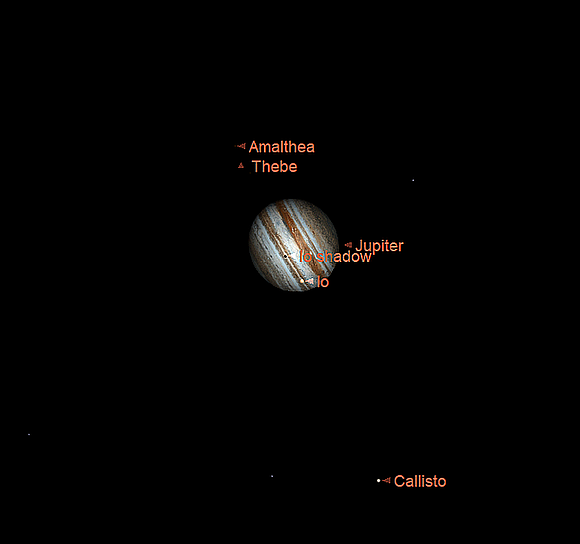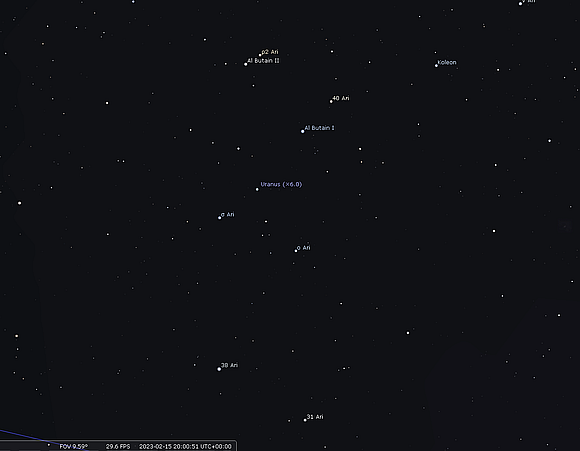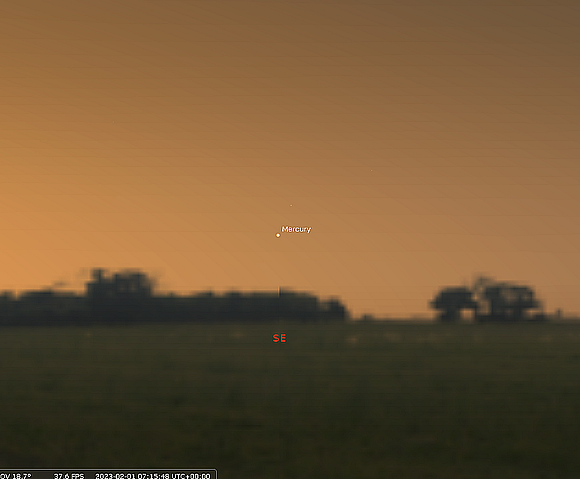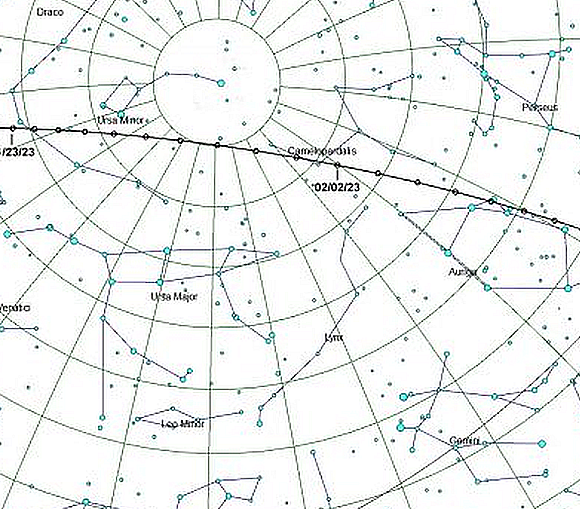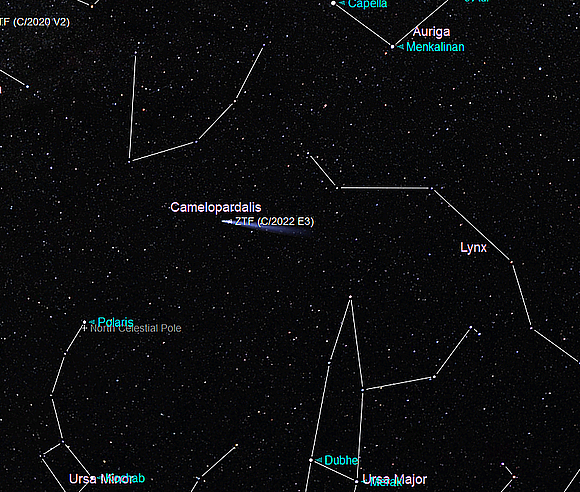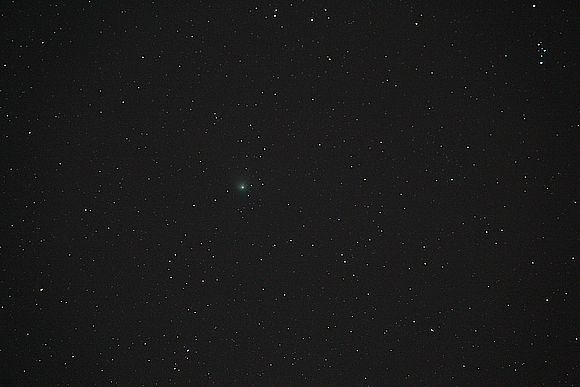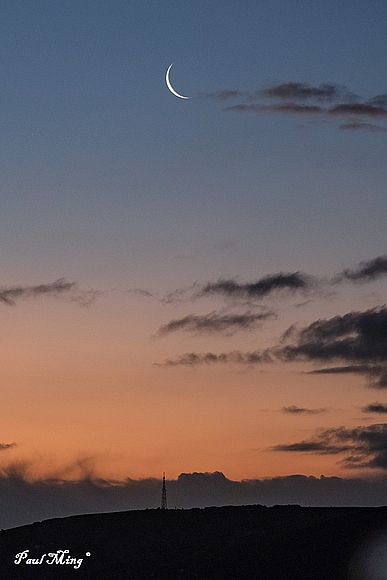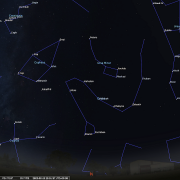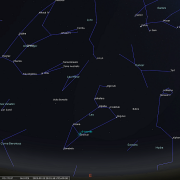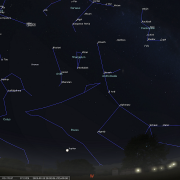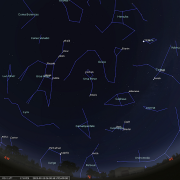In this month's Sky Notes:
- Planetary Skylights.
- February Meteors and Comet 2022 ZTF E3.
- February Night Sky.
- February 2023 Sky Charts.
Planetary Skylights - Brief
Saturn bids farewell to the evening sky. Jupiter drops lower to the SW horizon meeting Venus coming the other way, which starts to dominate the early evening twilight sky. Mars remains well placed, but is now declining in brightness. Neptune encounters Venus, whilst Uranus is well placed for telescopic observations.
 Mars - remains the best placed planet in the February night sky high up in Taurus, but is now declining in brightness, dropping to zero magnitude by the month's end. The Red Planet is nevertheless a conspicuous naked eye object, brighter than nearby Aldebaran (mag 0.87) chief star in Taurus, which is also orange in hue and makes a useful comparison this month. The two are separated by around 8 degrees, with Mars sitting to the north of Aldebaran, but moving eastwards again in prograde motion.
Mars - remains the best placed planet in the February night sky high up in Taurus, but is now declining in brightness, dropping to zero magnitude by the month's end. The Red Planet is nevertheless a conspicuous naked eye object, brighter than nearby Aldebaran (mag 0.87) chief star in Taurus, which is also orange in hue and makes a useful comparison this month. The two are separated by around 8 degrees, with Mars sitting to the north of Aldebaran, but moving eastwards again in prograde motion.
Through the eyepiece, Mars starts the month nearly 11 arc seconds in diameter, however by the end of February the Martian disk has shrunk to little more than 8 arc seconds and recognising surface detail will be more challenging. At least, with Mars riding high in the sky, the image quality should be pretty steady. Mars actually culminates on the south meridian over 60 degrees up. Patience at the eyepiece will be required, clear skies with twinkling stars usually equates to unsteady seeing, whereas nights with perhaps a little haze and steady stars will offer up better views. Magnifications of at least 100x will allow respectable views of Mars, as a rule of thumb, use 40X per 25mm of aperture, only rarely can a magnification in excess of 180x be employed from UK shores. At the start of February, the most prominent surface feature - the wedge or fin shape of Syrtis Major - will be presented to Earth early evening and will be visible during this period for 10 days or so, becoming a midnight feature by mid-month. Remember that a Martian day is roughly 30 minutes longer than an Earth day, so features will be visible half an hour later each day. The waxing Moon lies nearby Mars on the 27th and 28th of February.
 Venus is beginning to dominate the early evening twilight sky over in the SW gaining in altitude throughout February. Shining at mag -4.0, Venus becomes readily apparent 12-16 degrees above the SW horizon around 35-40 minutes after sunset, 17:30 - 17:45hrs GMT. It is preferable to have a clear uninterrupted horizon to aid in viewing Venus, certainly for this month, but as Venus gains in elevation and brilliance this will become less of an issue. As conspicuous as Venus appears to the naked eye, in the eyepiece it is rather a letdown, the surface perpetually hidden by a thick duvet of cloud, reflecting sunlight and trapping the heat - so that Venus suffers from a 'runaway' greenhouse effect, leading to hellish conditions on the planet. Observers at the eyepiece will note that like the Moon, Venus exhibits a phase which is currently gibbous in shape. Venus can be so bright it is often easier to spot the phase when viewed in light twilight.
Venus is beginning to dominate the early evening twilight sky over in the SW gaining in altitude throughout February. Shining at mag -4.0, Venus becomes readily apparent 12-16 degrees above the SW horizon around 35-40 minutes after sunset, 17:30 - 17:45hrs GMT. It is preferable to have a clear uninterrupted horizon to aid in viewing Venus, certainly for this month, but as Venus gains in elevation and brilliance this will become less of an issue. As conspicuous as Venus appears to the naked eye, in the eyepiece it is rather a letdown, the surface perpetually hidden by a thick duvet of cloud, reflecting sunlight and trapping the heat - so that Venus suffers from a 'runaway' greenhouse effect, leading to hellish conditions on the planet. Observers at the eyepiece will note that like the Moon, Venus exhibits a phase which is currently gibbous in shape. Venus can be so bright it is often easier to spot the phase when viewed in light twilight.
Venus has a busy month, gaining 4 degrees in elevation from 12 to 16, it then encounters Neptune on the 14th and 15th of February. A very slim crescent Moon resides below Venus on the 21st, and above Venus, below Jupiter the following evening, but the highlight of the month occurs at the end of February and just into March when Venus and a sinking Jupiter have a spectacular conjunction.
 At magnitude -2.2 Jupiter continues to be a dominant planetary object in the early night sky, but is now slipping down into the SW aspect and will become less ideal for observations. At the start of the month Jupiter is located quite high to the SW as dusk gathers, though by the month's end it is setting by 21:00hrs.
At magnitude -2.2 Jupiter continues to be a dominant planetary object in the early night sky, but is now slipping down into the SW aspect and will become less ideal for observations. At the start of the month Jupiter is located quite high to the SW as dusk gathers, though by the month's end it is setting by 21:00hrs.
A slim crescent Moon shines below Jupiter on Feb 22nd and above it the following evening. As Jupiter slides down to the SW horizon, it meets Venus coming the other way, so if you can watch over the final week of February; note how the two planets converge, ending with a spectacular conjunction at the very end of February and the start of March.
Through the eyepiece Jupiter is a fine sight, the oblate disk appearing an impressive 45 arc seconds in diameter and fascinating to study. Observations should be carried out early evening - when Jupiter rides higher in the sky noting the disk features, including the banding and GRS (Great Red Spot) - a colossal storm system. This appears to have diminished in size and hue intensity over the last few decades. It is visible in apertures of 100mm (4") and above.
Jupiter is flanked by the Galilean moons, viewed as specks of light close by, but planetary sized worlds in their own right. The 'dance' of Io, Europa, Ganymede and Callisto around Jupiter, continually throws up a different configuration each night. Particularly fascinating to view are shadow transits of these moons when passing on the near side of Jupiter. A 4" (100mm) aperture scope and above will reveal the jet black dots of varying size dependant on which moon is involved. The two most noticeable this month will be an Io shadow transit on Feb 19th at 19:30hrs and a Ganymede transit on Feb 25th at 18:30hrs.
 Uranus remains well placed for observation in the evening sky located in the lower reaches of Aries high in the SSW sky, well above horizon murk and turbulent air. At magnitude +5.7, the planet is technically visible to the naked eye, but dark, transparent skies are required to achieve this. Uranus can be spotted as a star-like object through binoculars, but the miniscule disk; ghoulish grey/green in hue and just 3.6 arc seconds in diameter, is revealed only in telescopes of apertures 75mm (3") and greater at medium magnification.
Uranus remains well placed for observation in the evening sky located in the lower reaches of Aries high in the SSW sky, well above horizon murk and turbulent air. At magnitude +5.7, the planet is technically visible to the naked eye, but dark, transparent skies are required to achieve this. Uranus can be spotted as a star-like object through binoculars, but the miniscule disk; ghoulish grey/green in hue and just 3.6 arc seconds in diameter, is revealed only in telescopes of apertures 75mm (3") and greater at medium magnification.
Perhaps the most difficult aspect of locating Uranus is indentifying the general area of sky in which it currently resides, a "no man's land" devoid of apparent naked eye stars below Aries, West of Taurus and to the east of Cetus and Pisces. The nearest 'bright' apparent naked eye star is sigma Ari at magnitude +4.35, which sits 1.5 degrees upper left of Uranus. Over the course of a month you will notice the movement of Uranus in comparison to background stars. The Moon lies 5 degrees upper left of Uranus on Feb 25th.
 Remote Neptune resides amongst the stars of northern Aquarius, some 6 degrees lower right of Jupiter, but is now low to the SW as twilight deepens and any observations will need to be undertaken in the first half of February. Shining as a feeble magnitude +7.8 object, you will require a telescope with an aperture of 100mm (4") + to reveal its tiny blue/grey disk barely 2.5 arc seconds in diameter. Your opportunity to track down Neptune may arise on February 14th and 15th when brilliant Venus lies just 54 and 16 arc minutes respectively above Neptune. View around 18:45hrs. Although Neptune resides just within the borders of Aquarius, the closest visible star is the mag +5.5 star 20 Piscium (HIP 117375) with 96 Aqr almost the same distance to the SW of Neptune. By the month’s end Neptune is lost in solar glare, so your make the most of the conjunction opportunity.
Remote Neptune resides amongst the stars of northern Aquarius, some 6 degrees lower right of Jupiter, but is now low to the SW as twilight deepens and any observations will need to be undertaken in the first half of February. Shining as a feeble magnitude +7.8 object, you will require a telescope with an aperture of 100mm (4") + to reveal its tiny blue/grey disk barely 2.5 arc seconds in diameter. Your opportunity to track down Neptune may arise on February 14th and 15th when brilliant Venus lies just 54 and 16 arc minutes respectively above Neptune. View around 18:45hrs. Although Neptune resides just within the borders of Aquarius, the closest visible star is the mag +5.5 star 20 Piscium (HIP 117375) with 96 Aqr almost the same distance to the SW of Neptune. By the month’s end Neptune is lost in solar glare, so your make the most of the conjunction opportunity.
 Technically, Mercury may be glimpsed due SW just above the horizon on the first few mornings of February at 07:00hrs, but it will be a challenge. View no later than 07:15hrs.
Technically, Mercury may be glimpsed due SW just above the horizon on the first few mornings of February at 07:00hrs, but it will be a challenge. View no later than 07:15hrs.
 Saturn bids farewell to the evening sky just a few days into February - lost in twilight glare as it sets. Saturn will return to the dawn sky during late April.
Saturn bids farewell to the evening sky just a few days into February - lost in twilight glare as it sets. Saturn will return to the dawn sky during late April.
February Meteor and Comet Activity
There are no recognised meteor showers of note during February, but you may still spot the odd sporadic meteor OR even a brilliant fireball via your door bell cam... who knew? The Alpha Aurigids are a very minor shower running from mid January thru' to mid February, however numbers are indistinguishable from sporadic levels; barely 2-5 per hour. That said, meteors witnessed at this time of year are quite often bright and it has been suggested that the period from late January to March; the 'fireball' season', may be a very old depleted shower of similar nature to the Geminids, composed of more dense, rocky debris. If you do spot a meteor speeding away from Auriga make a mental note, otherwise it's just an anonymous sporadic debris fragment.
Comet 2022 E3 (ZTF)

Comet ZTF E3 - (the green comet) image AP
Comet ZTF 2022 E3 is certainly not a 'great' or even particularly conspicuous comet; but as the comets go, it's at least brighter than the majority to visit the inner solar system. Discovered in March by the Zwicky Transient Facility, as of writing (Jan 30th) the comet is a border line naked eye object around mag + 5.4 and may just have been visible from a very dark site, however that pesky Moon is waxing, which means the chances of anyone spotting the comet when at its brightest is waning! Comet E3 reached perihelion on Jan 17th when 1.11AU from the Sun (102 million miles or 167 million km) which is not particularly close and was approximately +6.5 in magnitude. Having swiftly moved up into the northern reaches of the sky, becoming circumpolar mid January, comet E3 crossed through Draco and Ursa Minor in little over a week, entering Camelopardalis on January 28th. E3 is nearest Earth on Feb 1st some 43 million km distant, by which time it will be racing through the background stars of Camelopardalis at 17" per minute, an apparent motion noticeable in binoculars. The comet will then be over 70 degrees in elevation by the time astronomical darkness falls around 18:45hrs UT.
Estimating the brightness of a comet is never an exact science, but E3 is now expected to peak within the limits of naked eye visibility. As mentioned previously, moonlight will reduce the possibility of doing so. It is certainly an easy binocular object and has been observed by several members in late January. Mark D hunted it down with 15x70 binoculars, and it was still visible in 7x35 bins. A Full Moon occurs on Feb 5th, with the New Moon occurring on Feb 20th. The comet passes 1.5 degrees west of brilliant Capella in Auriga on the 5/6th before passing east of Aldebaran at a similar separation on the 14/15th by which time the comet will be travelling at 5" per minute and expected to be mag +6.5. At least by then the Moon will be absent from the evening sky. The comet will spend the rest of February tracking through Taurus and down ahead of Orion's shield stars. It will then be several magnitudes fainter. Make the most of any opportunities to observe the comet if you can - last time this comet visited was 50,000 yrs ago! Here are a few images members have been able to capture.
The comet captured by Richard Randle
Jan 17th @ 04:00hrs ISO 80000, single frame. (Click for larger image)
Mark D - Sony 400D - 28mm lens, F9, ISO 1600- Jan 25th. Comet just visible-
how it may have looked to naked eye from really dark site. (Click for full image)
John Lamb also imaged the comet, see below.
Comet ZTF E3 - taken from Abbey Car Park Jan 27th. Taken with Canon D550 and 55/250 Telephoto lens. Images: John Lamb
For accurate and up-to-date charts of comets please visit https://theskylive.com.
Finally, Paul Ming captured a very pleasing image of an old waning Moon seen above radio/tv mast at Ravenscar. The image was taken early morning of Dec 21st, 2022.
February Night Sky
Sshh, whisper it quietly, February evenings for northern temperate latitudes are definitely gaining in light, the darkest of winter days behind us, yet the worst of winter can potentially lie ahead. It is a bitter-sweet month. The night sky certainly reflects astronomical mid-winter, the seasonal winter constellations still shuffling toward centre stage during the evening, even though meteorological winter has barely 28 days left to run its bitter course before meteorological spring arrives, meekly or with a roar. One could argue that only then does the winter sky appear at its most majestic to observers.
For the time being, as true darkness engulfs February's burgeoning twilight, the western aspect of the night sky is still dominated by autumnal constellations, in particular the great square of Pegasus with the stars of Andromeda reaching up to the figures of Perseus and Cassiopeia now departing the zenith - overhead.
Circumpolar Summer stars are banished to the margins low to the north - as Vega and Deneb in Lyra and Cygnus respectively flirt with the horizon. These circumpolar luminaries will endure the winter nights and not seek warmer climes. Seemingly stood on its tail, the stars of the familiar Plough asterism indentify the location of the Great Bear. The 'pointer stars' in the bowl of the Plough, Dubhe and Merek point in the direction of Ursa Minor and in particular the Pole star, Polaris. The Celestial dragon – Draco winds its way between the two bears due North, the head of the beast marked by an irregular quadrilateral of stars not far from Vega. Overhead the distinctive ‘W’ pattern of Queen Cassiopeia first occupies the zenith, followed by Perseus (the outline of which resemble a distorted figure Pi symbol) and then the stars of Auriga the charioteer, highlighted by brilliant Capella.
It is the majestic stellar canopy to the South that really attracts the eye. Here the observer is treated to an array of imposing constellations, brilliant stars and observational interest. At the head of this wondrous stellar cavalcade sit the stars associated with the head of the Bull - Taurus. Known as the Hyades, the distinctive 'V', and very open star cluster contains the marmalade hue of Aldebaran - “the eye of the bull’, the most conspicuous presence in the Hyades, but not a true member residing 60 light years away, half the distance of the true Hyades members. Conspicuous Mars currently resides in Taurus not far from Aldebaran and is of a similar hue. Further west of the Hyades, the Pleiades star cluster (Seven Sisters) is a truly beautiful sight in binoculars or low power eyepiece. It is one of the most youthful clusters by stellar standards (150 million years), comprised of many hot, massive B class stars. Keen sighted observers can make out more than seven stars with the naked eye, although most people see six. Binoculars, or very low telescopic magnifications, reveal dozens of stars and the entire cluster contains over 300 members approximately 434 light years away.
By mid-evening, Orion - the mighty hunter, stands proud due South, the heart of the glittering tableau ranged around it. Observable from every inhabited place on Earth, the outline of the hunter is quite distinct; the three belt stars set betwixt a larger rectangle, two of these stars in the 'box', in opposing corners are genuine super luminaries’. Rigel illuminates the bottom right of the rectangle, a B7 class blue/white star at least 60,000 times more luminous than our Sun. The top left corner is marked by the fiery hue of Betelgeuse, a red super-giant star of gargantuan proportions, over 400 million miles in diameter and with one foot in the stellar grave. Betelgeuse is considered the strongest candidate of a star to go supernova within the next 10-20 thousand years, the recent temporary fading of this star, maybe an indication of the stars initial behaviour towards its cataclysmic fate. Rigel is also massive enough to end its days as a supernova, tens of millions years in the future, though short by stellar standards.
Situated just beneath the three stars marking Orion’s belt resides one of the great show piece objects in the night sky, the Orion nebula, the closest region of star formation to us, around 1300 light years. The Nebula, which is thought to be less than 2.4 million years old, consists of a huge cloud of gas and dust perhaps 25 light years in extent. Within the most dense clumps of gas, stellar formation is underway, unseen by optical obserrvation.
Seen clearly as a misty smudge through smaller binoculars, telescopically, or with very large binoculars the Orion nebula is quite a breathtaking sight, a swirl of nebulous cloud at the heart of which reside a trapezoid-shaped asterism from which the cluster gets its name, the Trapezium, the four “bully boys” of this stellar crèche. The brightest members are found within 1.5 light years of each other and have estimated solar masses of between 15 and 30 times our Sun. These young OB stars are luminous X-ray sources and are responsible for much of the illumination of the surrounding nebula. The powerful UV radiation force from these stars has hollowe d out a cavity in the nebula several light years across, allowing us to see the trapezium stars. It is thought many of the stars forming in the cluster are no more than 300,000 years old, with the brightest as young as 10,000 years. The Trapezium stars are easily seen with modest telescopes, even large binoculars will reveal them.
Upper left of Orion stand the Twins of Gemini, marked by the two conspicuous stars, Castor and Pollux. Castor, the most northerly of the pair, is slightly fainter than twin brother Pollux which shines with a pale amber lustre. Although Castor appears solitary, in reality it is a multiple system of which the brightest two components may be separated in a modest scope, given stable atmospheric conditions. Gemini is home to the fine open cluster M35.
The two hunting dogs of Orion, Canis Major and Canis Minor, dutifully follow their master across the heavens. The belt stars of Orion point down in the general direction of Canis Major and the most prominent of all night stars, sparkling Sirius, seen low to the SSE. Some distance above and left, solitary Procyon, in the lesser dog of Canis Minor, is yet another highly conspicuous winter jewel, the prominence of both stars primarily due to proximity; 8.6 and 11 light years respectively. Both stars have companion white dwarf stars, though they are very difficult to spot even with quite large instruments.
Look for the faint glow of the winter Milky Way which flows to the left of Orion, separating the two dogs on opposing banks. The dogs' quarry, the timid celestial hare of Lepus, may be traced crouching below Orion and above the southern horizon. Lepus contains one Messier object, M79, a distant globular cluster. Within the faint starry haze left of Orion, a more modern constellation is located, the heavenly unicorn of Monocerus. Its stars are faint and to the naked eye the area looks bland on first glance, but hidden just beyond our gaze reside a multitude of star clusters and nebulae.
Below the Unicorn, Puppis, part of the now defunct constellation of Argo Navis straddles the S horizon. It too is rich in galactic clusters and nebulae; including the Messier objects M46, M47 and M93. The longest constellation in the heavens (or at least a section of it) occupies much of the sky lower right of Orion. The river Eridanus, the source of which rises just to the right of Rigel, marked by Cursa or beta Eridii, then flows erratically parallel to the southern horizon before plunging through it, journeying far down into the southern hemisphere, ending at a brilliant star called Archenar.
Toward the back end of February, night finds Orion and his entourage already trooping into the west half of the sky, their places taken by an ensemble of spring constellations. The inconspicuous stars of Cancer scuttle after Gemini and mark the border of seasonal change from winter to spring. Leo the lion follows, identified by the distinctive ‘Sickle’ asterism, at the foot of which shines bright Regulus. The faint, but traceable head of Hydra sits below Procyon, and above the Water Snakes chief star, Alphard - the "Lonely one". The clock will be striking midnight before the rest of the snake slithers fully into view. Post midnight, Arcturus in Bootes and Spica in Virgo, join the victims of Hercules, pushing the stars of winter out of the door, ushering in spring, or so we hope.
February 2023 Sky Charts
Additional Image Credits:
- Planets and Comets where not otherwise mentioned: NASA
- Sky Charts: Stellarium Software and Starry Night Pro Plus 8
- Log in to post comments






